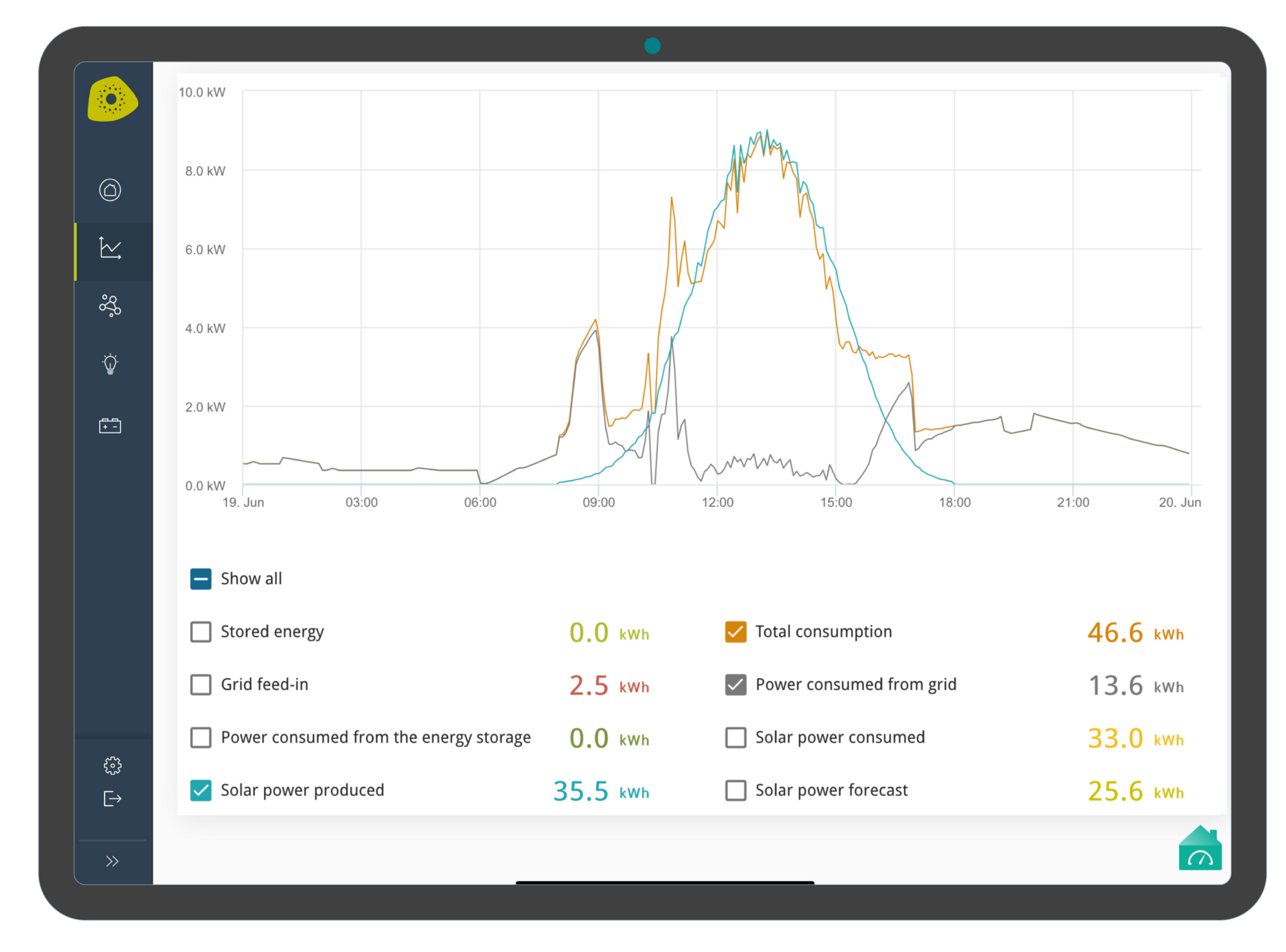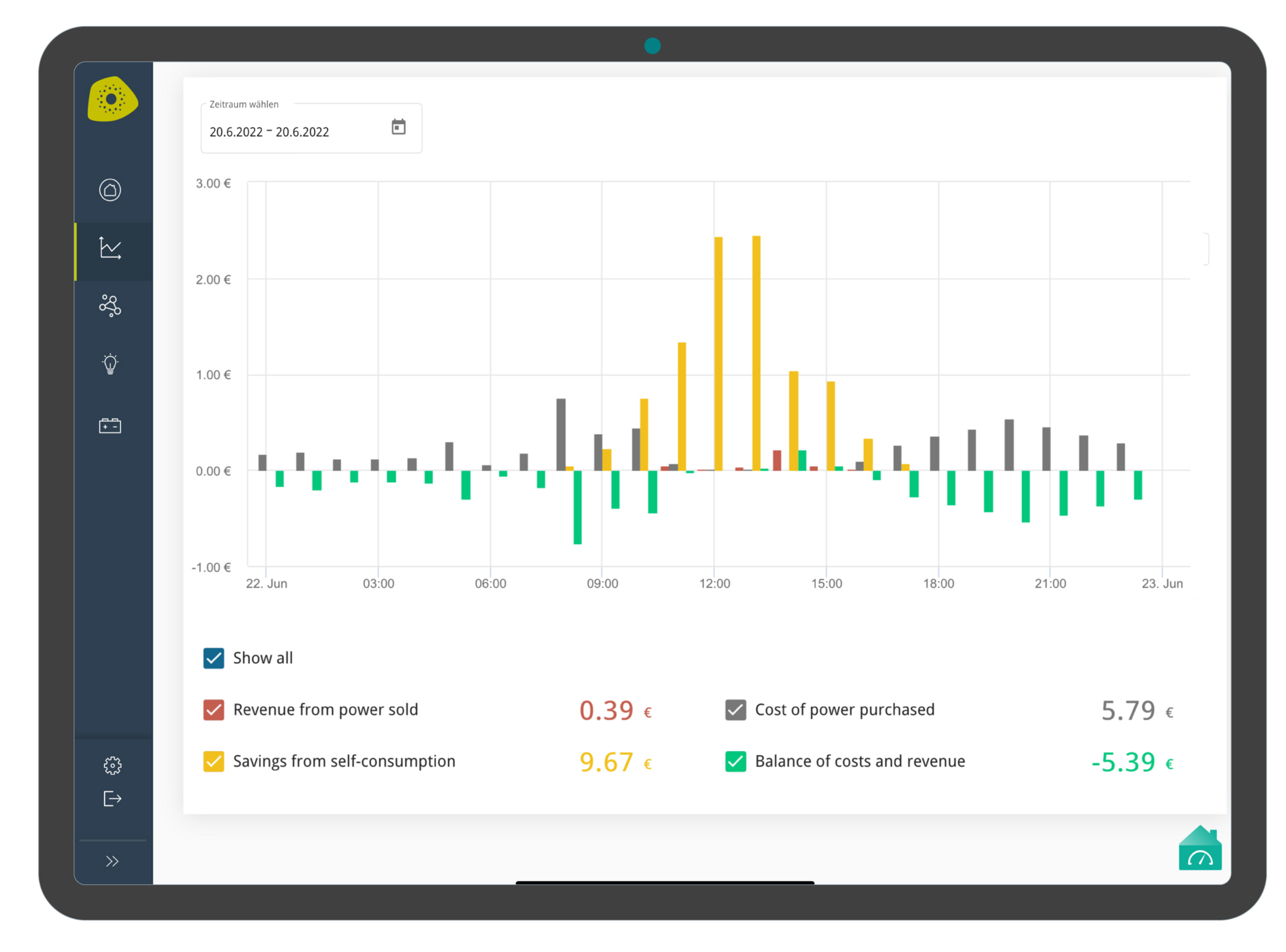To realize the decentralized energy transition, renewable energies must be used as efficiently as possible. Every one of us can contribute to this by optimizing our self-consumption. To do that, a home energy management system (HEMS) is indispensable.
With the help of the HEMS, flexible assets such as EVs and heat pumps can be solar-optimized, allowing homeowners to exploit the full potential of their PV systems. Kiwigrid’s convenient end customer portal, which is available as a web and mobile app, makes the individual configuration of self-consumption optimization easy. As we offer The Independent Home (TIH) as a white-label product, all functions can be tailored to your own corporate design.
How to increase self-consumption through solar optimization
It goes without saying that anyone who installs a PV system wants to maximize its use and power their household appliances with their self-produced solar energy as much and as often as possible. Only a HEMS makes this possible and allows for maximum independence from grid operators or electricity providers.
In the energy optimization section of the TIH end customer portal, users can configure the solar-optimized operation of flexible assets such as EVs, heat pumps and heating rods. In addition, individual time plans allow for devices to be switched on automatically. Self-produced energy is optimally used and never wasted.
While the analysis and processing of the necessary energy data by the HEMS is highly complex, the customer app makes this data clearly and easily accessible to end customers:
The following two scenarios show exactly how energy optimization works for individual energy devices:
Scenario 1: Solar-optimized charging of an EV
In the app, end customers can activate the solar-optimized charging mode to charge their EV with surplus solar energy. If the EV needs to be ready to leave at a certain time, departure time optimization can also be activated. This function ensures that the vehicle is charged with solar energy until the charging process approaches the previously set departure time. The power output is then maximized to fully charge the vehicle on time.
Users simply have to enter the desired departure time and EV battery capacity into the app. They also have the option to set a threshold value that the PV surplus must reach before the charging process begins.
Scenario 2: Solar-optimized charging of a heat pump
The heat pump can also be solar-optimized. For this purpose, the HEMS uses the control contacts of "SG Ready"- compatible heat pumps are operated within their control settings. The "SG Ready" label defines four modes of operation that are supported by compatible heat pumps:
1 EVU blocking time
2 (Energy) Efficient standard operation
3 Switch-on recommendation
4 Start-up command
As soon as there is a PV surplus, the start-up command is triggered by the HEMS. If there is no solar surplus, the HEMS returns the heat pump to efficient standard operation.
Prioritizing energy devices and time-based optimization
If energy optimization is configured for both the heat pump and the EV home charger, how do you determine what gets charged first? Users can drag and drop individual schedules in the app to adjust this to their needs. The order in which the devices are displayed corresponds to the order in which they will be charged. This prioritization is based on device-specific switching parameters.
Configuring minimum run time
In the PV optimization section users can also set additional switching parameters such as a minimum run time and rest time. In addition, there is an option for setting a threshold value that the PV surplus must reach before the device is switched on.
Setting a minimum run time can be useful for devices such as a dehumidifier that only operate effectively if they run for at least one hour at a time. It also prevents devices from switching on and off several times in close succession due to the set PV surplus threshold.
Intuitive customer experience: transparent, clearly presented results
To make optimizing self-consumption intuitive for end customers, it’s crucial to allow for a simple configuration of the various functions and to present the results transparently.
Therefore the app displays the most important data at a glance:
- Cost savings achieved thanks to self-consumption optimization
- Current total consumption
- Source of consumed electricity (PV system, energy storage, grid)
- Degree of self-sufficiency in the last three months
- Charge status of the energy storage device
Customizable energy flow diagrams answer additional questions about the current electricity output, the degree of self-sufficiency and the share of self-consumption. The analysis section offers a daily, weekly and monthly view.
Our clients can individually adapt the displays of our TIH user interface according to their corporate design, so that each client’s app is unique on the energy market.
Kiwigrid's manufacturer-independent, cross-sector HEMS connects devices from different manufacturers, all device classes and various complex setups. This versatility makes it future-proof and internationally scalable for our clients. Our white-label product TIH delivers an all-round solution for end customers who want to optimize their self-consumption.
Want to learn more about TIH's diverse capabilities? Check out the TIH section and follow us on LinkedIn!



